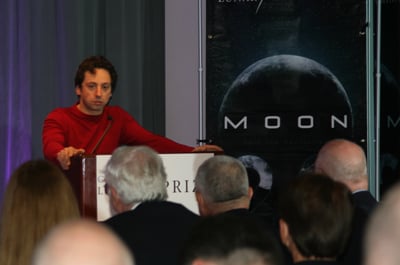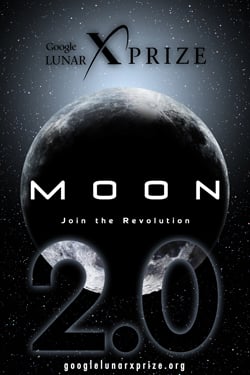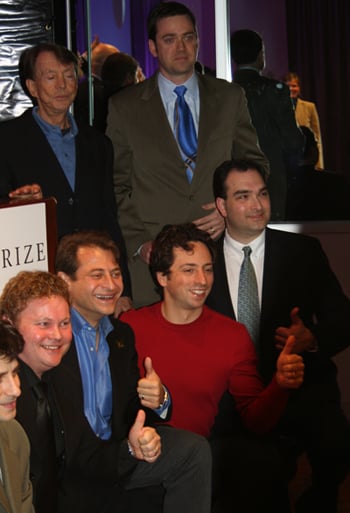Original URL: https://www.theregister.com/2008/02/22/google_xprize_lunar_teams/
Google encourages 10 teams to rocket to the moon
Lunar X Prize joined by Jesus, a penguin and some miners
Posted in Science, 22nd February 2008 01:56 GMT
Google and the X Prize Foundation held a ceremony today for the first ten contestants to enter their $30m race to land a privately funded space craft on the Moon.
Eight new teams have joined the previous two entrants, who all gathered at the Googleplex in Mountain View, California to preview their intentions for the purse.
The firms have until the end of 2012 to land an unmanned machine on the lunar surface and successfully send it roving for at least 500 meters. The winning team will receive a $20m grand prize for their effort. That's potentially a fraction of the cost it will take to land a machine there — although some entrants claim they can make it with a budget less than the grand prize.
Second prize is $5m for a team that successfully lands their craft, but cannot make it travel over 500 meters. An additional $5m will be awarded if the rover can go over 5,000 meters.
Google co-founder Sergey Brin said the company decided to put its funds toward the competition after a regular corporate brain storming session.
Brin's curiosity about the the cost to land a craft on the moon left him shocked about its bargain value (in the eyes of a man who lands his jet in a private NASA runway usually reserved for presidential visits, of course).
"This aspect of discovery is being ignored despite its relatively low cost," said Brin.

Sergey Brin: A man who can afford not to wear a suit
The X Prize Foundation aims to spur technological development in space the same way a cash prize tempted Charles Lindbergh to cross the Atlantic by aircraft in 1927. After that, your bevy of Amelia Earharts are bound to follow.
Yet this is a program nurtured and raised in Silicon Valley, and therefore lacks a reasonable amount of shame. That's why we see "Moon 2.0" slogans plastered around for this competition. That's right, "Moon 2.0." Love it, kiss it, rub it all over your naked body.

No, really
Let's meet the contestants.
Odyssey Moon
Odyssey Moon is a privately held lunar venture based in the Isle of Man. The company was the first official entry for the competition, announcing their intentions December 6, 2007 at the Space Investment Summit in San Jose, California.
Odyssey says its strategy involves "a unique small robotic lander" made to deliver scientific and commercial payloads to the surface of the Moon.
The company's rally cry is that it will take on early risks of lunar travel to prove that it's possible — then use its position to sell "inexpensive and reliable lunar products and services to others."
Odyssey's craft for the Lunar X Prize is called "MoonOne (M-1)"
Astrobotic Technology
Second to enter, Astrobotic formed just two months after Google announced it would offer $30m for the Lunar X Prize. The company is an amalgamation of technology from Carnegie Mellon University, security contractor Raytheon Company, and The University of Arizona's Lunar and Planetary Laboratory.
The company, headed by William "Red" Whittaker of Carnegie Mellon, has set a goal of landing a rover in the Sea of Tranquility and assessing the Apollo 11 mission landing site.
Last November, Whittaker led a Carnegie Mellon robotics team to win the $2m first place prize in an autonomous vehicle contest, DARPA Urban Challenge.
Astrobotic intends to combine similar technology for the rover with The University of Arizona's lunar research, and Raytheon's propulsion and guidance systems.
Astrobotic's competing crafts are called "Artemis Lander" and "Red Rover."
FredNet
Team FredNet wants to triumph a Moon landing in the name of open source code.
FredNet is composed of three software and hardware developers leading an international group of engineers and scientists. Their strategy is to utilize the same approach for developing open source software in order to build and launch a small lander and several lunar rovers approximately the size of a cell phone.
"We firmly believe in our open source strategy," said team leader Fred Bourgeois. "We truly are one people, one planet, working together to solve big problems."
FredNet said they will hold an elementary school-level competition to name the rover and space vehicles.
Team Italia
Team Italia brings together several universities and the "young heart of Italy," according to team leader Amalia Erocoli-Finzi-Politecnico di Milano.
The team said reliability and costs are the driving factors for its mission design. Scientific objectives are secondary. It prefers a soft landing on the Moon using dedicated thrusters, after the craft orbits around the Moon for a few days to finalize operations. They are currently deciding whether to use a single big rover, or many smaller robots to trundle about the lunar surface.
Micro-Space
Microspace is a Colorado-based company that specializes in developing space flight systems. The company claims its accomplishments include flying 17 bipropellant liquid fuel rockets, three near-hover rockets with vectored thrust guidance, radio-tracked flying, and developing several innovative life support systems.
"I want to thank the lord Jesus Christ for this opportunity," said team leader Richard Speck at the press event, holding up a piece of paper with a cross printed on it.
Speck said that the company plans to apply technology used in landing a lunar rover for a future Mars mission, and for creating an "Ultralight Human Moon Lander." He continued that the mission would reflect that the dangers of space flight have historically been greatly exaggerated.
ARCA
Aeronautics and Cosmonautics Romanian Association is a private organization headquartered in Valcea, Romania.
The team was one of the lead contenders for the Ansari X Prize in 2002, and intends to have even greater success with a Moon landing.
One of ARCA's most innovative projects thus far is Stabilo, a two-stage manned suborbital vehicle. The first stage uses what ARCA says is the world's largest Solar Montgolfier balloon. When the craft is at the appropriate height, a rocket powered manned spaceship is launched from the balloon.
SCSG
Southern California Selene Group describes its spacecraft as "an elegantly simple design that is relatively inexpensive to implement." The craft, dubbed "Spirit of Southern California," will be designed to "hop" to its destination once landed.
Members of the team hold a combined 131 space-related patents and have had active participation in over 500 space missions, SCSG said.
At the event, team leader Harold Rosen scoffed at the idea being promoted by the X Prize Foundation of mining resources on the Moon to send to Earth as "ridiculous." But other teams such as Odyssey are more optimistic about the proposition.
Quantum3
Quantum3 Ventures believes the first voyage to the Moon in 35 years can and should be led by an American team showcasing American technology.
The firm is spearheaded by three former advisers from NASA and the US Senate. It plans to use a partnership approach to the contest, making alliances in both the private and academic sector to build its lander.
It proposes to launch a small spacecraft called "Moondancer" in 2009 from the US east coast for a soft landing at the Sea of Tranquility.
Lunatrex
Lunatrex was formed only this year, and is composed of individuals, companies and universities from the Mid-West. Its combined stable of knowledge combines rocket science, high-altitude near-space R&D, aviation design, robotics, trajectories, and non conventional propulsion expertise.
"We want to make a repeatable, sustainable business model to land on and orbit the Moon," said team leader Pete Bitar.
The company has the lofty goal of making a craft for less than the amount of the prize money. Lunatrex claims the decision is not about profit, but proving that space is accessible even to small business.
Chanda
Chanda (meaning "Moon" in Sanskrit) is a bit of a dark horse in the competition.
Team leader (and sole member) Adil Jafry said he decided to enter the competition six weeks ago after reading the Lunar X Prize press release.
Jafry said he became excited about the prospect of landing a vehicle on the Moon, and began to research the subject - later paying the $1,000 to enter the contest.
He describes himself as an energy entrepreneur, having formed Tara Energy (Tara is "star" in Sanskrit) out of deregulation of the energy industry in Texas. Jafry believes the space industry is on the cusp of a similar boon as energy deregulation for private entrepreneurship.
Jafry said he's since purchased about 25 books on technical, commercial and regulatory aspects of the space industry to help him build the company from scratch. ®
Bootnote:
